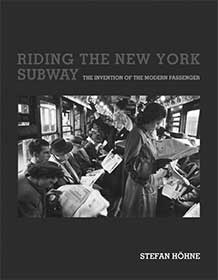
Text from the publisher:
Stefan Hohne. MIT Press 2021. 392 p.
A history of New York subway passengers as they navigated the system’s constraints while striving for individuality, or at least a smooth ride.
When the subway first opened with much fanfare on October 27, 1904, New York became a city of underground passengers almost overnight. In this book, Stefan Höhne examines how the experiences of subway passengers in New York City were intertwined with cultural changes in urban mass society throughout the twentieth century. Höhne argues that underground transportation—which early passengers found both exhilarating and distressing—changed perceptions, interactions, and the organization of everyday life.
Over the decades, discourses surrounding the subway system shaped passengers alternately as progressive heroes, fragile cargo, barbarians, patriots, or vigilantes. At the same time, authorities saw passengers as undisciplined masses posing a threat to order. Höhne investigates how authorities attempted to control passenger behavior with rules and regulations in an effort to ensure efficiency in transit. Meanwhile, passengers asserted their individuality by resisting imposed norms and inventing subversive practices.
Critically engaging with the work of Michel Foucault and other theorists, Höhne maps the subway–passenger relationship from the system’s inception to its 1968 consolidation into the Metropolitan Transit Authority, as the subway—once a monument to progress—became a neglected infrastructure plagued by crime and fear. Höhne shows that throughout the course of the twentieth century, New York City subway passengers struggled to navigate the system’s constraints while striving for individuality, or at least a smooth ride.
Topics: metro, passenger car, USA